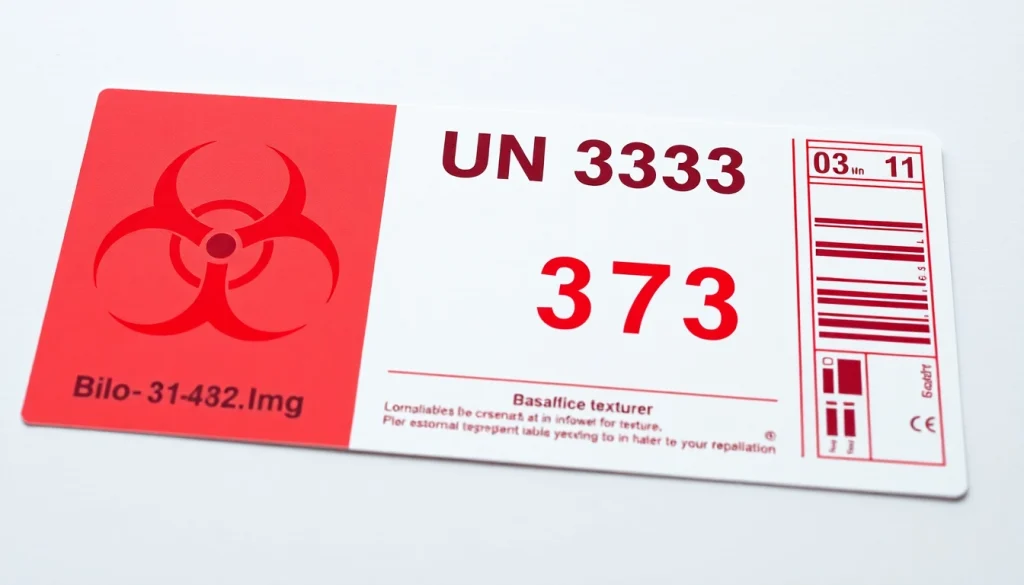
Understanding the UN 3373 Label
What is a UN 3373 Label?
The UN 3373 label is a crucial component in the shipping of biological substances classified as Category B. Under international regulations, specifically relating to the transportation of dangerous goods, this label serves to notify handlers and personnel of the presence of these materials, ensuring careful handling and compliance with safety protocols. Category B biological substances include human or animal specimens, such as tissues and fluids, being shipped for purposes like diagnostic testing or research.
Importance of UN 3373 in Shipping
Shipping biological substances can pose significant health risks if not properly handled. The UN 3373 label is essential as it not only complies with regulatory requirements but also acts as an immediate visual cue to inform carriers and emergency responders of the potential hazards. Additionally, accurate labeling helps avoid delays in transit, as incorrectly labeled packages may be subjected to additional scrutiny or even refusal of shipment. Ensuring the proper use of the un 3373 label augments safety measures surrounding the transport of these materials.
Regulatory Requirements for UN 3373 Labeling
The regulatory framework governing the UN 3373 label involves both national and international guidelines, primarily dictated by the International Air Transport Association (IATA) and the United Nations. These regulations stipulate specific criteria regarding the labeling, packaging, and documentation of biological substances. Compliance is vital to avoid legal repercussions and to uphold safety standards. For example, the label must be clearly visible on the outer package, indicating the nature of the contents in a format that is recognizable across multiple jurisdictions.
Key Features of the UN 3373 Label
Design Elements of the UN 3373 Label
The design of the UN 3373 label is standardized to facilitate global recognition and compliance. Typically, these labels feature a white background with black text and the symbol for biological hazards prominently displayed. This universal design helps in quickly identifying the contents as biological substances, ensuring that safe handling procedures are followed. The label may also include additional instructions regarding storage and transport conditions, such as refrigeration requirements.
Color Codes and Symbols Explained
Understanding the color codes and symbols on the UN 3373 label is crucial for anyone involved in the transportation of biological substances. The primary colors of the label serve both an aesthetic and functional purpose—white for clarity, black for contrast, and additional colors may denote specific risks associated with the package contents. The triangular biohazard symbol signifies that the contents may pose a risk of infection, directing handlers to employ appropriate precautions.
Text and Information to Include
Important text and information on the UN 3373 label includes the proper shipping name (“Biological Substance, Category B”), the UN classification number (3373), and any necessary handling instructions. To ensure compliance and facilitate safe transportation, it may also be necessary to include the name and address of the sender and recipient, emergency contact information, and more specialized handling instructions if applicable.
How to Properly Apply UN 3373 Labels
Label Placement on Shipments
Proper label placement is key to ensuring that the UN 3373 label serves its intended purpose in the shipping process. The label should be affixed to the outermost package, ideally on the same side as the package opening to ensure visibility. Care should be taken to ensure that the label is not obscured by other labels, markings, or tape. Additionally, the label must be applied to packages sensitive to environmental conditions, such as those containing refrigerated specimens.
Tips for Ensuring Compliance
To ensure compliance with UN 3373 labeling requirements, shippers should implement a systematic approach to their shipping processes. This includes training staff on the importance of proper labeling and the implications of non-compliance, regularly reviewing packing materials and methods for vulnerabilities, and maintaining updated records of all shipments. Additionally, investing in quality labels that withstand environmental conditions can also mitigate potential shipping issues.
Common Mistakes to Avoid
One of the most common mistakes involving UN 3373 labels is improper labeling or placement, which can lead to shipment delays or penalties. Other frequent errors include failing to utilize the correct label size or format, mislabeling the contents, and neglecting to include necessary handling instructions. To avoid these issues, it’s imperative to establish thorough checklists and validation protocols prior to shipment.
Purchasing UN 3373 Labels
Where to Buy Valid UN 3373 Labels
Purchasing valid UN 3373 labels is essential for anyone involved in shipping biological substances. Reliable sources include specialized suppliers that focus on laboratory and medical shipping supplies, online marketplaces that offer compliance-certified labels, and local retailers that stock adherence to such regulations. Always ensure to verify that the label meets current regulatory standards before making a purchase.
Comparing Prices and Quality
When comparing prices for UN 3373 labels, it’s essential to balance cost against quality. Cheaper labels may not withstand the rigors of transport or may lack the durability and adherence properties required to ensure compliance. Look for suppliers that provide detailed product descriptions, customer reviews, and guarantee compliance with legal standards. Bulk purchasing can often alleviate cost per unit while ensuring that your supply is consistently available.
Custom Label Options
For organizations with specific needs, custom UN 3373 labels can be beneficial. Custom labels allow for additional information relevant to the specific substances being shipped, such as type of biological material, special instructions for transport, or internal tracking codes. Engaging with a reputable supplier to develop custom labels ensures compliance with both regulatory requirements and your unique operational needs.
FAQs about UN 3373 Labeling
What is included in Category B Biological Substances?
Category B Biological Substances, as classified under the UN 3373 label, typically include human or animal materials that may contain pathogens. These substances can range from diagnostic specimens, such as blood, urine, and tissue samples, to research materials. Understanding what qualifies as Category B is critical for compliance and safety throughout the shipping process.
Is the UN 3373 label considered a hazardous material?
While the UN 3373 label itself does not classify a substance as hazardous material in the same context as other dangerous goods, it indicates that the contents could be infectious and require careful handling. Recognizing the difference is important for compliance with applicable laws and legal frameworks, such as the IATA Dangerous Goods Regulations.
What happens if a shipping label is incorrectly applied?
If a shipping label, such as the UN 3373, is incorrectly applied, it can lead to several issues, including possible delays in delivery, legal penalties, or even the rejection of the shipment by transport carriers. Incorrect labeling can also pose safety risks for handlers who may not be adequately informed about the nature of the contents in the shipment. It’s crucial to adhere to labeling guidelines to prevent these complications.






